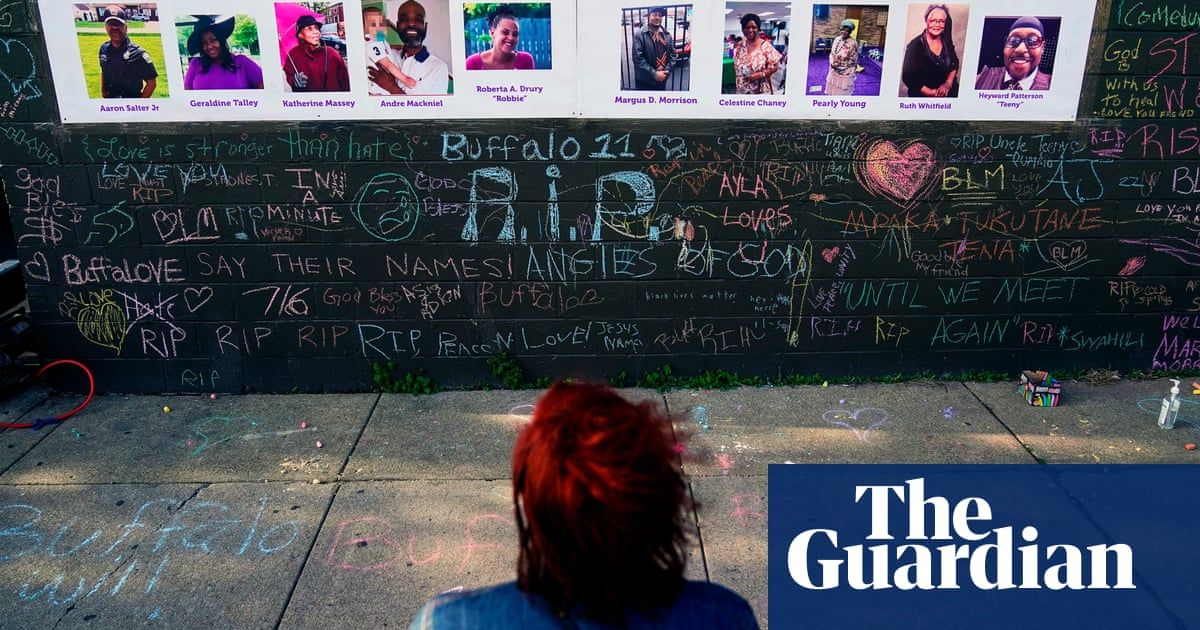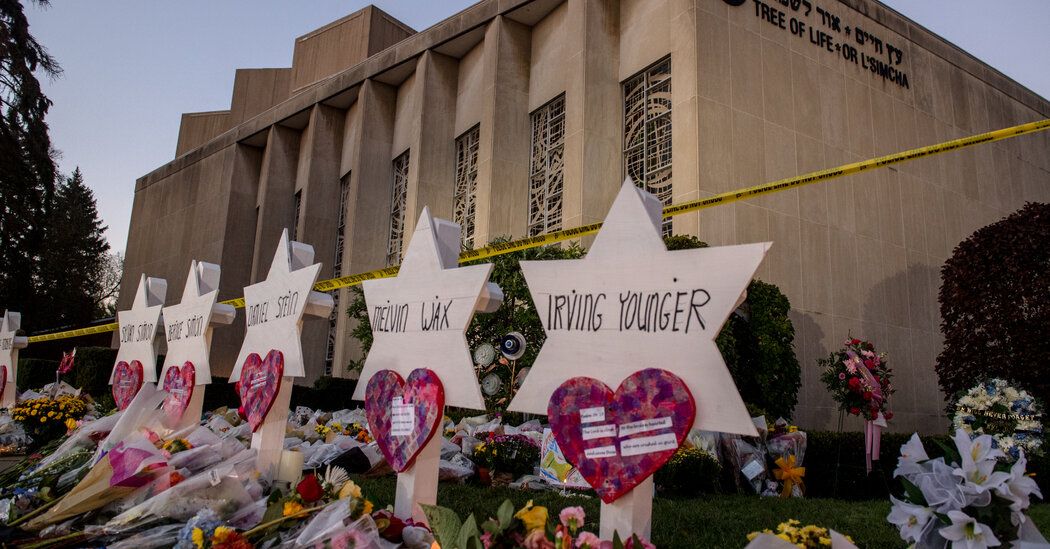‘Nothing changed’: Buffalo’s East Side still struggling a year after shooting
A year ago, a white supremacist gunman committed a mass shooting at a Tops Friendly Markets on Buffalo’s East Side that left 10 people dead, several more injured, and a community forever changed.
The predominantly Black East Side neighborhood lost its only grocery store for two months and a day, once again making the area into a food desert. In the gunman’s wake came national and international media – and, with them, widespread attention from charitable organizations and people.
At the time, some community members were skeptical: how long would this attention last? What would happen once the cameras left? Would the community receive any lasting investment? Immediately after the shooting, many community members said that nothing would change and that any progress would leave as soon as the cameras did.
A year later, many people who live on the East Side say that they were proved right: when the cameras left, so did the potential for change and investment. It is still an area struggling with gun violence, underfunded schooling, a lack of grocery options, poor transportation and joblessness.
‘It’s like Groundhog Day’
14 May, commonly referred to as “5/14” by Buffalonians, was brutal for the entire community. But the devastation was particularly significant for some. It’s the day Mark Talley lost his mother, 62-year-old Geraldine Talley, and the day Garnell Whitfield, Jr, former fire commissioner of the Buffalo fire department, lost his mother, 86-year-old Ruth Whitfield.
Following the shooting, Talley went to Jefferson Avenue and started volunteering with multiple organizations. Ultimately, he started his own non-profit, Agents for Advocacy. Since forming the organization, Talley has hosted 30 events “related to socioeconomic improvement or classes on the East Side”. His book about the shooting and its aftermath, The Day the Devil Came to Buffalo, will be released on the first anniversary of the massacre.
From his vantage point, the early fears of the community members were proven right.
“Nothing has changed,” said. “Everything is still stagnant. People helped out in the beginning when the news and camera stations were all here, then they left, leaving the community to fend for themselves … Now it’s like Groundhog Day. With the one year anniversary approaching, those people are coming back again, trying to get more marketing time.”
Talley says that the tragedy became a photo op for people, mostly outsiders, who were not willing to stick around and continue doing the work once the cameras are gone.
A police officer lifts the tape cordoning off the supermarket in Buffalo following the shooting in May 2022. Photograph: Matt Rourke/AP
Whitfield said he understands there are some who seek to use 5/14 for their own personal gain, but he hopes community members will be able to use the increased attention to right historical narratives.
“We don’t need everybody, we need a few good people to facilitate change,” he said. “If we don’t do this, we’re going to fall victim to all those who would have historically written our narratives for us, written our story for us and left us out of history. This is an opportunity to make sure that what happened here in Buffalo is remembered and that the story is complete and that it’s our story, from our perspective.”
Myles Carter, who lives in Tonawanda, a suburb of Buffalo, but is involved with the East Side, says that the rest of the city has returned to “business as usual”.
“5/14 existed, the people and victims from there are still struggling to get the resources they need to survive,” he said. “And Buffalo is moving on.”
‘5/14 happens every day in our communities’
The massacre did not create the issues on the East Side. But the tragedy put a magnifying glass on them.
Malik Stubbs, an East Sider who one day hopes to be mayor of Buffalo, has consistently advocated for more grocery stores and food options in the area. When the store was closed following the shooting, Tops officials bused East Siders to various Tops locations, while organizations and community members distributed food and groceries.
But with only the Tops reopened, the ongoing lack of transportation and other food options now gives residents a stark choice: purchase food from the grocery store in which 10 community members were massacred, or struggle to figure out another option.
“It’s hard to go back into Tops and not think about what happened,” Stubbs said. “We don’t have grocery stores, most of us don’t have cars, so it’s harder for us to get groceries.”
But Carter says focusing on the East Side being a food desert doesn’t go far enough. Gentrification is a pervasive issue through Buffalo in general, he said, but it is now seriously impacting the East Side. Many people from outside buy and flip properties on the East Side, displacing longtime residents.
“The reality is resources,” Carter said. “People have no means of transportation. People have been evicted from the properties that they were renting, not only because they can’t afford it, but because the property has been sold from beneath their feet.”
People embrace outside the supermarket in Buffalo, New York, in May 2022, following the shooting. Photograph: Matt Rourke/AP
Carter says it’s important to remember that the people who were working at Tops were working at a minimum wage job and Stubbs says that the lack of employment opportunities and transportation add to East Siders’ struggles.
“People on the East Side have to travel outside of their own neighborhoods just to get employed,” Stubbs said. “[But] in communities outside of the East Side, it’s easier to get the bus or the train. If you have to get a bus or a train on the East Side, it takes forever.”
There is a litany of changes advocates and residents would make, from transportation to housing to jobs to education – and that list has not changed since before the shooting.
“5/14 happens every day in our communities. This is not something new. It didn’t start on 5/14. 5/14 happened here, I lost my mother here, but the truth is everyday people are dying in the streets of our communities,” Whitfield said. “People are dying [from] gun violence, drugs and alcohol, lack of healthcare, lack of resources, being criminalized and profiled by the police, being under-resourced, communities being redlined, the values of our properties being devalued, losing our generational wealth.”
According to a 2018 study by the Partnership of Public Good (PPG), 85% of Black Buffalonians live east of Main Street, making Buffalo one of the most segregated cities in the country. That area is also home to every single one of the 51 census block groups in the city of Buffalo that have limited access to grocery stores. A 2021 study by the University of Buffalo Center for Urban Studies found that “Black Buffalonians have not made progress over the past 31 years”. As recently as 2019, Buffalo was the third poorest city in the nation and the city with the second-highest childhood poverty rate.
In 2022, PPG released a policy brief about Buffalo’s lead exposure crisis. “5.83% of children in Buffalo, NY tested for blood lead level between 2000 and 2014 suffered from lead exposure,” the brief reads. “That’s three times the rate in Flint.”
“This has been going on for generations. It’s all by design. It’s all intentional,” Whitfield said. “All of these things are underpinned by a society built on the principles of white supremacy. This country is built on those principles. What happened here in Buffalo, our condition here in Buffalo, is not by accident. Our condition in this country is not by accident.”
The white supremacy that motivated a teenager to drive several hours to murder Black people, many of whom were elderly, is the same white supremacy that continues to squeeze the East Side, advocates say.
“It’s not just a Buffalo thing,” Carter said. “This is representative of Black, Indigenous people all over this country. We are struggling to have ownership of our communities … so we’re losing. We’re the loss of everybody else’s opportunity.”
Whitfield and African Heritage Cooperative co-founder Alex Wright both say that racism is the thing that people are hesitating to acknowledge despite it being the root of the problem.
“We’re not talking enough about that, we’re not talking enough about racism, we’re not talking enough about why it’s so important to teach more than Black history in our schools. It’s this big elephant that we want to sweep under the rug and pretend doesn’t exist,” Wright said.
‘Where is the money?’
In March, Hochul announced more than $1.4m in federal funding for mental health programs on the East Side. This came after she previously announced $2.5 million in State funding for those impacted by the shooting and $50 million of targeted investments in the area, while other organizations and groups also promised and raised substantial funds.
But many of those on the ground – the survivors of the Tops shooting, victims’ family members, community advocates and members – largely say that the previously allocated funds have not tangibly helped people and have been slow to move. They doubt new funds will help change their material conditions.
In his work with survivors of the shooting, Carter says there “is a struggle to get people what they need”.
He says that he keeps hearing about the millions of dollars, but he has not actually seen it in any real way.
“What money are you talking about? That’s my question. People keep saying ‘millions of dollars’, [and] I don’t even know what you’re talking about,” he said. “That’s the reality. People out here who are connected to the victims, doing the work, don’t know what you’re talking about when you say ‘millions of dollars’.”
A man prays at a memorial at the Tops supermarket in Buffalo, New York, in May 2022. Photograph: Brendan McDermid/Reuters
Carter says some of the survivors with whom he is in community are struggling to pay their bills, while others are trying to support their families on low wage jobs. If there were millions of dollars, he asks, why aren’t these people seeing any of it?
The African Heritage Food Cooperative (AHFC), launched in 2016, is “an answer to the lack of Black food store ownership in the Black community”, according to the co-op’s Facebook page. Following the shooting, AHFC received $200,000 from the United States Department of Agriculture’s (USDA) Healthy Food Financing Initiative to enhance their locations on the East Side and in Niagara Falls. AHFC received $3m as part of Hochul’s targeted East Side investments.
While the attention is on the East Side, Wright hopes people are able to make systems that will outlast waning interest.
“What we need to do is make sure that while the attention is here and while there are resources, that we put together systems that allow for self-sufficiency,” he said.
Prior to the shooting, AHFC was trying to raise $3m to convert 238 Carlton Street, an 1876 building that was originally constructed as a grocery store and residence before being vacant for the last several decades, into a full-service grocery store. The store will have eating spaces and community spaces, along with access to much needed fresh produce. The funds from the State funded it outright. A model of the building sits in the AHFC’s East Side location.
Whitfield thinks it was naïve for people to assume that the millions would “fix issues overnight”.
“It’s naive to think a few million dollars would ever be [enough],” he said. “Not that I’m not grateful for it, but it’s naïve to think it could turn around generations of under-resourcing, of criminalization, of redlining, of all the things that have stolen our generational wealth, with a few millions dollars. That’s a drop in the bucket; it’s an acknowledgment.”
Source: The Guardian US


